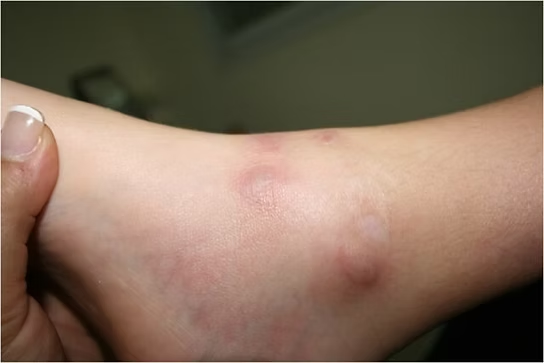Raynaud’s Phenomenon
- Fysiobasen

- Dec 15
- 4 min read
Raynaud’s phenomenon is a condition characterized by episodes of sudden changes in skin color on the fingers and toes in response to cold or psychological stress. During an attack, the fingers typically turn white first, then blue, and finally red – a sequence reflecting blood vessel constriction (vasospasm), followed by oxygen deprivation and then the return of blood flow (reperfusion)¹.
Raynaud’s phenomenon mainly affects the blood vessels in the fingers and toes, but can also involve the nose, lips, and earlobes².

History and Definition
The condition is named after the French physician Maurice Raynaud, who first described it in 1862 as “episodic, symmetric, peripheral vasospasm with pallor, cyanosis, and a sensation of pressure or pain”³. Raynaud’s phenomenon can occur as an isolated disorder or as part of another disease.
Types of Raynaud’s Phenomenon
Raynaud’s phenomenon is divided into two main types:
Primary Raynaud’s phenomenon (Raynaud’s disease): Occurs independently, without underlying disease, and usually has a mild course⁴.
Secondary Raynaud’s phenomenon: Occurs as a result of another condition, particularly connective tissue diseases such as systemic sclerosis (scleroderma), lupus, or rheumatoid arthritis. The secondary form is often more severe and carries a higher risk of complications⁵.
Causes and Triggering Factors
The exact cause of Raynaud’s phenomenon is unknown, but heredity, altered nerve control over blood vessels, increased sensitivity to cold, and circulating blood cells are thought to play a role. Both primary and secondary forms can be triggered by:
Exposure to cold (e.g., cold weather, cold water)
Emotional stress
Blood disorders with elevated platelets or red blood cells
Abnormal vascular reflexes (increased vasospasm)
Underlying conditions such as systemic connective tissue disease (lupus, scleroderma), carpal tunnel syndrome, atherosclerosis, repetitive vibration, or trauma
Smoking, certain medications (for hypertension, migraine, ADHD, or cancer), chemicals, and frostbite⁴ ⁵ ⁶
Symptoms and Clinical Presentation
Symptoms usually appear in the fingers and toes and vary depending on severity, frequency, and duration of vasoconstriction:
Skin turns white (ischemia), then blue (cyanosis), and finally red (reactive hyperemia)
Tingling, numbness, or mild pain in fingers or toes
Swelling and discomfort
With prolonged oxygen deprivation: sores or ulcerations on fingertips, and in severe cases, tissue death (gangrene)
In rare cases, the nose, lips, or ears may also be affected¹ ⁶
Diagnosis
Raynaud’s phenomenon is a clinical diagnosis. There is no blood test that directly confirms the condition, but the evaluation should always include:
Thorough medical history focusing on occupation, smoking habits, and family history
Examination of the hands for signs of connective tissue disease (ulcers, thickened vessels)
Blood tests to exclude underlying conditions (complete blood count)
Nailfold capillaroscopy (microscopy of vessels around the nails) to detect characteristic changes
Additional investigations if an underlying disease is suspected¹ ⁵e sykdom¹ ⁵
Treatment and Medical Management
Raynaud’s phenomenon cannot be cured, but symptoms can often be alleviated, and complications prevented with an individually tailored plan:
Prevention: Avoid cold and damp environments. Use warm gloves, thick socks, and scarves, especially during winter.
Smoking cessation: Smoking causes vasoconstriction and increases the risk of attacks.
Avoid vibration and trauma: Use protective equipment and avoid vibrating tools if ulcers or known Raynaud’s are present.
Avoid medications and chemicals that may worsen symptoms.
Pharmacological treatment: In severe cases or with ulcers, calcium channel blockers or other antihypertensive agents (e.g., sartans), or intravenous vasodilators such as iloprost, may be used⁷.
Finger protection: In case of ulceration, use protective bandages or finger guards.
Patient education: Patients should be informed about how to prevent attacks and which strategies help during an episode.
Primary Raynaud’s usually causes only transient discoloration and rarely requires more than lifestyle adjustments. Secondary Raynaud’s requires more thorough follow-up, especially to monitor ulcer development.
Prevention
Measures to prevent Raynaud’s attacks include:
Avoiding cold and sudden temperature changes
Avoiding smoking and stress
Avoiding medications or chemicals that cause vasoconstriction
Maintaining good skin care and treating ulcers promptly¹
Risk Factors
Raynaud’s phenomenon occurs more frequently in women than men and often begins in adolescence or early adulthood. Risk factors include:
Underlying connective tissue diseases (lupus, scleroderma, rheumatoid arthritis, Sjögren’s syndrome)
Smoking
Hand injuries or previous frostbite
Side effects of medications
Chemical exposure
Family history⁶
Complications
In most cases, Raynaud’s only causes temporary discomfort. In severe secondary forms, prolonged or repeated oxygen deprivation may lead to:
Ulcer formation on fingertips (digital ulcers)
Infection and necrosis
Tissue death and, in rare cases, amputation⁷
Sources:
Herrick AL. Raynaud’s phenomenon. Journal of Scleroderma and Related Disorders. 2019;4(2):89–101.
Cleveland Clinic. Raynaud's Phenomenon. Available from: https://my.clevelandclinic.org/health/diseases/9849-raynauds-phenomenon [accessed 05.07.2025]
Medscape. Raynaud Phenomenon. Available from: https://emedicine.medscape.com/article/331197-overview [accessed 05.07.2025]
Hopkins Medicine. Raynaud's Phenomenon. Available from: https://www.hopkinsmedicine.org/health/conditions-and-diseases/raynauds-phenomenon [accessed 05.07.2025]
Mayo Clinic. Raynaud's disease. Available from: https://www.mayoclinic.org/diseases-conditions/raynauds-disease/symptoms-causes/syc-20363571 [accessed 05.07.2025]
MedicineNet. Raynaud's Phenomenon and Disease. Available from: https://www.medicinenet.com/raynauds_phenomenon/article.htm [accessed 05.07.2025]
Korsten P, Müller GA, Rademacher JG, Zeisberg M, Tampe B. Rheopheresis for digital ulcers and Raynaud's phenomenon in systemic sclerosis refractory to conventional treatments. Front Med. 2019;6:208.
Johns Hopkins Rheumatology. Raynaud’s Phenomenon: What You Should Know. Available from: https://www.youtube.com/watch?v=Jv0kEFCYF5M [accessed 05.07.2025]
Brigham and Women’s Hospital. Raynaud’s Phenomenon Video. Available from: https://www.youtube.com/watch?v=Aml-vSYWHrg [accessed 05.07.2025]









